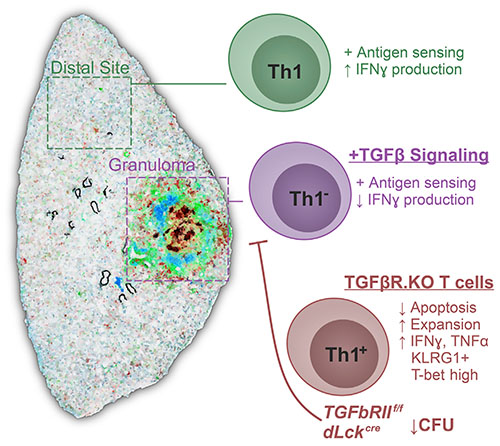Immunosuppressive Granuloma Microenvironments
 One of the main reasons immunity fails in TB is that immune cells cannot go to the right place. Furthermore, the granuloma environment limits cellular function even if they can traffic to the right place. Indeed, our previous work has found that T cell positioning and functioning are deficient within granulomas. A significant reason for this is the immunosuppressive cytokine TGFβ. We have found that when T cells no longer respond to TGFβ, they have improved function, live longer, and can improve infection outcomes.
One of the main reasons immunity fails in TB is that immune cells cannot go to the right place. Furthermore, the granuloma environment limits cellular function even if they can traffic to the right place. Indeed, our previous work has found that T cell positioning and functioning are deficient within granulomas. A significant reason for this is the immunosuppressive cytokine TGFβ. We have found that when T cells no longer respond to TGFβ, they have improved function, live longer, and can improve infection outcomes.
Our lab is carefully characterizing the effects of TGFβ on immune cells within the granuloma in much more detail. Further, TGFβ is not the only immunosuppressive factor within granulomas. Therefore, we aim to determine what factors significantly inhibit immune responses to Mycobacterium tuberculosis within infected sites using our cutting-edge approaches.
The treatment for tuberculosis is challenging for patients. For uncomplicated pulmonary TB with no drug resistance, it involves four antibiotics for two months, followed by two antibiotics for four months, and often involves significant side effects. However, drug resistance makes treatment much more complex, involving medications with more side effects and prolonging the treatment duration by months. Our lab hopes to inform the design of improved treatments for TB by harnessing our knowledge of what is essential for protective immunity to inform the design of host-directed therapies (HDT). Such HDT could result in shorter treatment courses and less drug resistance.
